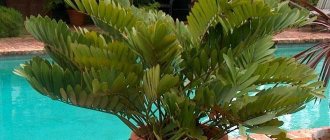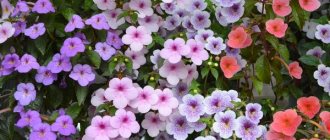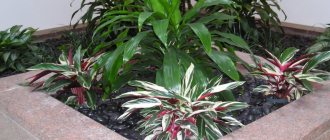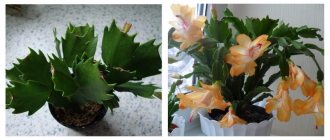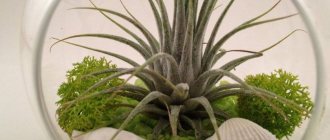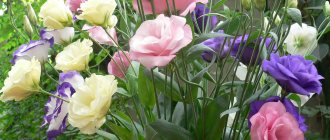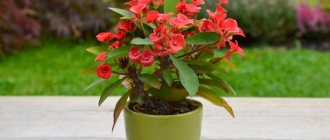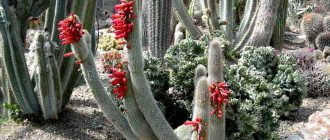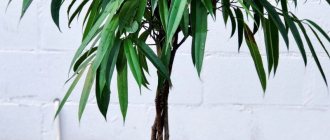Sarracenia is one of the rare and amazing plants called green predators. It belongs to the perennial herbs of the Sarracenia family, all representatives of which are insectivorous. Growing in swamps poor in nutrients, plants feed on insects to make up for the deficiency of essential substances.
The unusual lifestyle also affected the appearance of the plant. In sarracenia, modified leaves grow directly from the thick rhizome, rolled into a hollow tube. Approximately in the middle of the tube there is a thickening where water accumulates and where the secretion is released, with the help of which insects that get inside are digested. This device is called a “trapping pit” or “trapping jug”, since in most species of sarracenia the leaves really look like miniature jugs. The upper part of the leaf is an open funnel with a kind of canopy of leaf blade. The edges of the funnel and "canopy" are brighter in color, often with decorative veining and patterns, which makes them look like a flower and serves to further attract insects.
Unlike other types of carnivorous plants, Sarracenia is a passive predator. It does not forcibly restrain its victims, like the sundew, which secretes a sticky liquid, or the bladderwort, which slams its trap shut at the slightest pressure. Attracted by the beautiful appearance and aroma emitted by special glands that secrete nectar inside the leaf, the insects gradually descend deep down. And their reverse movement is prevented by the hairs that cover the walls of the trap. Some researchers even found half-digested remains of small frogs in hunting jars.
Sarracenia is one of the largest green predators. It has a thick and oblong rhizome 25–30 cm long, and pitcher-shaped leaves collected in a rosette, called ascidians, can reach 70–100 cm in height and up to 8 cm in diameter. But there are species that are much smaller. The leaves are usually light green with reddish or yellowish veins or purple.
Sarracenia flowers are attractive and interesting with their unusual shape. They are large, with a diameter of 4 to 10 cm, located on a long leafless peduncle. The calyx consists of 5 lobe-shaped petals, and in the center there is a wide, umbrella-shaped pistil. The color of the flowers is red, purple or yellow. Flowering period: late spring – early summer.
The plant's natural distribution area is small - mainly the southern and southeastern parts of North America along the Atlantic coast, from Canada to the Gulf of Mexico. Some of the species are currently under threat of extinction. In European countries with a mild climate, sarracenia is grown in garden culture, and in Russia it appeared in private home collections even before the revolution.
Common types of sarracenia
The genus Sarracenia includes 10 species, many of them have more or less common subspecies. There are also garden forms, varieties and hybrids that differ in shape, color or size of leaves and flowers.
Purple (S. purpurea) is the most common species in nature and in culture. After introduction, it adapted perfectly and currently grows wild in peat bogs in Western Europe. There are five known subspecies of Sarracenia purpurea, of which two are the most popular in cultivation:
- purple purple (S. purpurea ssp. Purpurea) - with reddish leaves that become richly colored in the sun. The height of the leaves is about 15 cm, and the peduncle is up to 30 cm. The flowers are red, sometimes greenish-purple, the trapping jugs are horizontally oriented. However, there are forms of the same subspecies with yellow and green leaves.
- purple veined (S. purpurea ssp. Venosa) - with larger burgundy or greenish-purple leaves. The flowers are also larger than those of the purple subspecies - dark burgundy, red-violet or pink.
Yellow (S. flava) is a species characterized by a wide variety of forms and varieties. The type variety has yellow-green leaves with red veins, noticeably ribbed, 60–70 cm high, and yellow flowers on drooping peduncles. In addition, there are varieties with large leaves, colored only green or in combination with red veins, with a copper-colored neck and “lid,” and red forms are especially valued by collectors. After purple sarracenia, it is the second most popular species grown indoors.
Psittacina (S. psittacina) is the only species among the representatives of the genus that is distinguished by aggressive behavior. The trapping leaves are widely spread and resemble a claw with a dome-shaped canopy. When insects get inside, they stick. The color of the leaves is dark burgundy, sometimes almost black. The flowers are red, but there is also a yellow-flowered form. In nature, plants of this species grow on the wettest soils, sometimes even submerged in coastal waters.
Red (S. rubra) is a plant native to the southeastern United States and classified as a rare species. The length of the trapping leaves is 20–60 cm, each ending with a long red sponge, which serves to attract insects. The main color of the leaves and flowers is also red: from scarlet to dark burgundy. There are several subspecies, the rarest of which is Saracenia red Alabama (S. rubra ssp. alabamensis), in which young leaves are light green with dark green veins, and mature ones turn orange-brown. Flowers are chestnut.
Very rare species in the wild and in cultivation include S. leucophylla, S. minor, S. alata and Sarracenia farhamii. All have leaves that are predominantly green, often with reddish veins, sometimes lighter at the top. The flowers are red, burgundy, yellow, less often white or cream.
Description
The genus Sarracenia includes 11 species that grow in the wild. Natural habitat is peat bogs of North and South America. Later, the flower was introduced to Central Ireland, where it adapted perfectly to new conditions due to a similar climate.
The most interesting characteristic is that Sarracenia is a carnivorous predator. Above the rosette rise leaves collected in a large funnel. They are a trapping device that catches various insects attracted by the strong aroma. After the insects land on the leaf, they slide down the slippery surface. Inside the funnel, fibers grow in a certain direction, which prevent the victim from getting out. In the storage trap of the leaf plate there is gastric juice in which the insect is gradually digested.
Like all plants, sarracenia cannot consume protein. From the victim, it absorbs only trace elements - magnesium, nitrogen, potassium and calcium, remaining after decomposition. Some birds use this flower as a feeder, flying to it for prey. Moreover, according to the observations of scientists, sometimes even small tree frogs end up in funnel traps.
Some insects are able to secrete substances on the surface of the body that prevent digestion, so they live comfortably inside the flower, eating other victims.
In the wild, the plant can form huge thickets, towering 80 cm above the swamp as a continuous carpet. The smallest varieties grow no more than 10 cm; these are the species most often used for growing at home.
Care and cultivation of sarracenia
Sarracenia is not a difficult plant to care for. If you create suitable conditions for it, then even novice gardeners can grow an excellent predator.
It is grown outdoors on marshy soils and only in mild climates. In room culture, 3 parts of high-moor peat, two parts of pure quartz sand and one part of sphagnum are mixed as a substrate. To improve the beneficial properties, you can add a little charcoal. For utensils, it is better to use not one, but two deep pots or a pot and a flower pot. The inner walls of the larger container are lined with sphagnum and a smaller pot with a plant is inserted into it. In addition to the substrate, at the bottom of smaller dishes there must be a drainage layer of polystyrene foam, broken bricks or shards from old clay pots.
In order for the leaves and flowers of sarracenia to have a beautiful, rich color, it needs a lot of light. In the room, the most suitable for it will be a south window, and in the summer the plant can be taken out to an open balcony. The duration of daylight during the growing season should be at least 8–10 hours, so artificial supplementary lighting is desirable.
In the active phase of growth and flowering, the optimal temperature should be 23–25 degrees Celsius, but an air temperature of +30°C is also acceptable. In winter, a period of rest begins, at which time the temperature should be reduced to at least 10–15 degrees Celsius. At home, you can set up a cold greenhouse right on the windowsill, separating the plant from the rest of the room with plastic film or glass, and remove the lighting during this time. Without a cold winter, sarracenia will still please the eye for some time, but will gradually begin to lose its attractiveness and wither away.
The plant has increased requirements for soil moisture. Therefore, from April to October, watering should be abundant and regular. Water into a tray, immersing the lower earthen ball in rain or distilled water by 2–3 cm. During dormancy, the frequency and intensity of watering is reduced, but the substrate should remain slightly moist. Moderate relative humidity is preferred. In hot weather, it can be maintained by wetting the sphagnum layer between the pots or placing the dishes on a wide tray with wet sand. Spraying from above is not recommended.
Any feeding of sarracenia is contraindicated; it is also not necessary to feed it with insects at home, especially large ones, which are poorly digested and can cause rotting of the leaves. It is important to ensure a constant flow of air indoors; she does not like it when the pot is turned or frequently moved from place to place.
Replanting is recommended once every two years or annually, depending on how much the roots have filled the dishes. The most favorable time for transplantation is early spring. Sarracenia can grow under natural conditions for up to 30 years, but in indoor culture this period is much shorter.
Problems and diseases
A plant that has been provided with proper care is practically not susceptible to disease. It can become a preventive trap for parasitic insects and protect all indoor flowers from pest invasion. But if mistakes were made in the care, then the beautiful sissy will demonstrate all her capriciousness.
The main difficulty in controlling pests or diseases is the ban on spraying. No substances should get inside the jug: neither folk remedies, nor insecticides. Therefore, the spraying procedure is replaced by wiping. The table contains descriptions of the main plant diseases.
Table - Problems of sarracenia and methods of treating predators
| Symptoms of the problem | Cause | How to fix |
| — The plant stops growing; - a gray coating appears on the leaf plates | — Gray rot | — Cut off all damaged areas; — arrange daily ventilation of the room (but not a draft!); - treat the plant with “Fitosporin M” or “Fundazol” |
| — Sarracenia begins to wither; - small pests are visible on the plant | — Aphids | — Increase the humidity in the room; - lower the temperature; - hang Velcro to catch insects; - remove visible pests; - trim damaged areas; - gently wipe the sheets with soapy water; — in case of severe damage, use insecticides: “Fitosporin”, “Aktara”; - if the roots are affected by the mealybug, replant in new disinfected soil and remove the affected roots |
| — Deterioration in the appearance and growth of the plant is accompanied by the appearance of lumps of cotton wool on the leaf | — Mealybug | |
| — Leaf blades turn yellow and dry out; - sarracenia is entangled in a thin web | — Spider mite |
To ensure that caring for sarracenia in a pot is not accompanied by the appearance of problems and diseases, carefully monitor the condition of the green predator. Sarracenia will definitely let you know about mistakes in care. Yellowing of the foliage indicates a lack of light or excess potassium in the soil. And the lack of flowering and drying out may indicate improper wintering or insufficient watering. But if the roots or leaves begin to rot, it means that the watering was excessive. Immediately replant the sarracenia and moderate soil moisture.
Propagation of Sarracenia
Sarracenia can be propagated by cuttings of rhizomes and seeds. Dividing the root system is most easily tolerated. yellow, but this is often not recommended so as not to weaken the plant.
Seeds must undergo cold stratification. Before sowing, they are soaked for 24 hours in distilled water, then sown in a moist substrate of sphagnum and sand in a shallow container. Cover it with polyethylene and put it in the refrigerator for a month, not forgetting to moisten the substrate. After keeping them cold, containers with seeds are placed under artificial light lamps without removing the protective film. Germination occurs within a month, then the sprouts sprout. Seedlings are planted in separate pots only after a year.
Wintering
For sarracenia, wintering is extremely necessary. It lasts for 3-4 months at an ambient temperature of 0-10ºС. Due to decreased daylight hours and lower temperatures, the “pet” goes into hibernation. Due to the characteristics of our region, this process occurs naturally in late autumn.
If the plant overwinters for the first time, then it is better to maintain the ambient temperature in the range from +5 to +7ºС. For “experienced” representatives of Sarracenia, the temperature can drop to -10ºС. It is necessary to water the plant with water whose temperature is comparable to the temperature of the air and soil.
All brave souls who are not afraid of the predatory abilities of Sarracenia and the difficulties of its care will be rewarded with a wonderful exotic pet that will delight you with its beauty!
Plant care
Sarracenia is easy to care for, but it differs from the usual care that applies to most indoor plants. There are nuances that need to be taken into account.
Watering sarracenia
Sarracenia loves water very much, as it lives on the banks of reservoirs. If you planted this predator on the shore of a pond on your site, then you don’t need to water it. A flower planted in a pot needs to be watered with water - distilled or filtered in such a way as to remove minerals and salts. Distilled water can be purchased at a gas station or auto shop, as well as at a pharmacy.
Watering is done from a tray, in which water should always be present in a decent amount, approximately half the level of the pot. It is necessary that the substrate never dries out, with the exception of hibernation. But even then it should be watered once a week, avoiding complete drying out.
Fertilizer and feeding
If your sarracenia lives outdoors, it does not need to be fed. She is able to take care of herself and obtain food that will satisfy her nutritional needs. You can offer her suitable food once, maximum twice a month.
A predator growing in captivity requires feeding:
- small insects;
- earthworms;
- bloodworm and so on.
You need to feed the plant that has mature trapping leaves. If your flower does not cover the trap with an umbrella, you need to fill the tubular jug halfway with distilled water and, in order to stimulate active growth, add ants to the diet, feeding the pet several live insects once a month.
Wintering sarracenia
All types of sarracenia require a winter respite, which lasts 3–4 months. Sarracenia needs to overwinter for long-term existence, as well as for the implementation of its own natural cycle, in particular the possibility of flowering.
The plant should be kept in a cool room with a temperature from 0 to 10°C. It can comfortably overwinter, for example, in the vegetable compartment of the refrigerator. At the same time, the intensity of watering decreases sharply, and the main task for this period is to prevent the substrate from drying out. Weekly moisturizing is quite enough for this.
